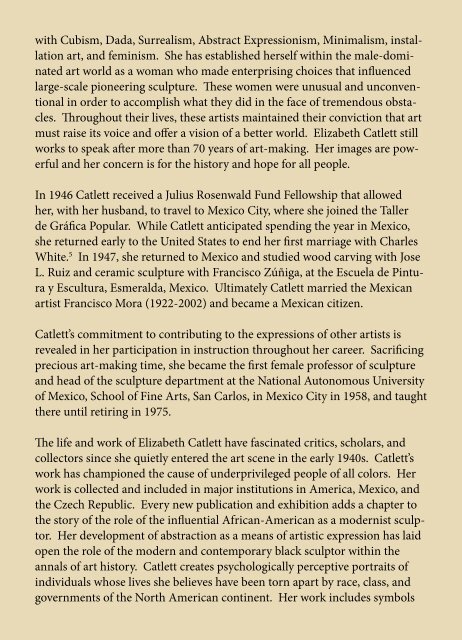The Art Of Elizabeth Catlett Sculptures And Prints
The Art Of Elizabeth Catlett Sculptures And Prints
The Art Of Elizabeth Catlett Sculptures And Prints
Create successful ePaper yourself
Turn your PDF publications into a flip-book with our unique Google optimized e-Paper software.
with Cubism, Dada, Surrealism, Abstract Expressionism, Minimalism, installation<br />
art, and feminism. She has established herself within the male-dominated<br />
art world as a woman who made enterprising choices that influenced<br />
large-scale pioneering sculpture. <strong>The</strong>se women were unusual and unconventional<br />
in order to accomplish what they did in the face of tremendous obstacles.<br />
Throughout their lives, these artists maintained their conviction that art<br />
must raise its voice and offer a vision of a better world. <strong>Elizabeth</strong> <strong>Catlett</strong> still<br />
works to speak after more than 70 years of art-making. Her images are powerful<br />
and her concern is for the history and hope for all people.<br />
In 1946 <strong>Catlett</strong> received a Julius Rosenwald Fund Fellowship that allowed<br />
her, with her husband, to travel to Mexico City, where she joined the Taller<br />
de Gráfica Popular. While <strong>Catlett</strong> anticipated spending the year in Mexico,<br />
she returned early to the United States to end her first marriage with Charles<br />
White. 5 In 1947, she returned to Mexico and studied wood carving with Jose<br />
L. Ruiz and ceramic sculpture with Francisco Zúñiga, at the Escuela de Pintura<br />
y Escultura, Esmeralda, Mexico. Ultimately <strong>Catlett</strong> married the Mexican<br />
artist Francisco Mora (1922-2002) and became a Mexican citizen.<br />
<strong>Catlett</strong>’s commitment to contributing to the expressions of other artists is<br />
revealed in her participation in instruction throughout her career. Sacrificing<br />
precious art-making time, she became the first female professor of sculpture<br />
and head of the sculpture department at the National Autonomous University<br />
of Mexico, School of Fine <strong>Art</strong>s, San Carlos, in Mexico City in 1958, and taught<br />
there until retiring in 1975.<br />
<strong>The</strong> life and work of <strong>Elizabeth</strong> <strong>Catlett</strong> have fascinated critics, scholars, and<br />
collectors since she quietly entered the art scene in the early 1940s. <strong>Catlett</strong>’s<br />
work has championed the cause of underprivileged people of all colors. Her<br />
work is collected and included in major institutions in America, Mexico, and<br />
the Czech Republic. Every new publication and exhibition adds a chapter to<br />
the story of the role of the influential African-American as a modernist sculptor.<br />
Her development of abstraction as a means of artistic expression has laid<br />
open the role of the modern and contemporary black sculptor within the<br />
annals of art history. <strong>Catlett</strong> creates psychologically perceptive portraits of<br />
individuals whose lives she believes have been torn apart by race, class, and<br />
governments of the North American continent. Her work includes symbols


